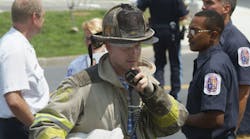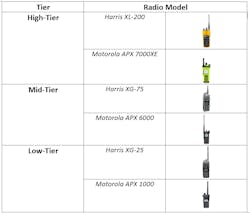Every year, the United States faces deadly hurricanes, wildfires, and other grave disasters, which require a well-coordinated emergency response effort to save lives and mitigate the destruction. Communication is critical in implementing such a response, from the local communities up to the FEMA Director and the President.
There are several communication tools utilized by FEMA in the face of a disaster, including
- Runners
- Cell phone
- Two-way radio
- Computers
Each method of communication plays an important role in the overall response. The most common and dependable method is the use of two-way radios with teams on the ground.
Runners provide FEMA with eyes and ears, consisting of local individuals communicating on the ground to give officials the information required to make decisions such as curfews, evacuations, or rescue teams. These runners are an advantage to FEMA because of their familiarity with the environment, no training needed, and their availability of volunteers.
Cell phones are the most common device carried by individuals regularly, making them one of the most effective assets in getting information to people in danger and the officials running the operation. For example, alerts can be sent right to cell phones in the case of a flash flood or other imminent disaster to evacuate or take cover. These devices are not without their limitations as cell towers may fail due to power outages or an overloaded system.
Computers have many capabilities including their ability to process large amounts of information and providing an electronic record that can be used to develop better strategies for future incidents. Downfalls of these tools do exist, as they require a power source, may not be mobile, and usually need internet connectivity to operate effectively.
Two-way radios are deemed as the most reliable and widely used tools during an emergency, able to operate without external power supplies or the communications infrastructure that devices such as cell phones rely on. They operate by sending and receiving information through various frequencies, which are divided into a variety of channels. Frequencies are regulated by the Federal Communications Commission (FCC), which has the power to determine who is allowed to use them.
Communication Failures in Actual Disasters
In recent events, disasters have shown various issues in our communication systems and how we should prepare for alternative solutions. Each emergency exposes flaws in our response systems, forcing us to enhance our communications infrastructure to prevent these failures.
One prominent example is Hurricane Katrina in 2005. The storm obliterated the local communications system, causing line breaks, destroying base stations, and cutting off the power which rendered cell phones, landlines, and internet connections inoperable. The 2011 earthquake in Mineral, Virginia, which did not cause major damage, overloaded the cell phone networks on a large portion of the East Coast.
There are many more instances where the systems we rely on have failed us in critical situations. In most cases, the failures occur in newer, more fragile technologies such as cellular networks or the internet. Because of the lacking reliability in these systems, FEMA has put two-way radios at the forefront of their communication structures during an emergency. History has shown that compared to cell phones, two-way radio infrastructure is more dependable. As a result, in past disasters as well as future ones, two-way radios will remain the backbone of effective emergency response.
Types of Radios
Radios are split into three tiers based on ruggedness and performance, and different types of responders should be equipped with a type based on their job. For instance, first responders in critical positions such as firefighters should be provided with high-tiered radios. This ensures that top-level performance is provided to them in the harshest environments. On the other hand, support staff working in less threatening circumstances should be provided with lower-tiered radios.
Examples of radios in each tier are listed in the figure below:
Radio Accessories Critical to Emergency Response
On top of selecting the right radio for the situation, there is also a selection of radio accessories that enhance your communication response plan. These include,
· Radio Holsters
· Antennas
· Headsets
· Batteries
· In-Vehicle Chargers
Radio Holster
For starters, having a strong radio holster is vital in protecting your device from harsh situations such as rain or dust. Radio cases also help prevent the radio from being dropped which could cause it to break. You will also know where your radio will be at all times and avoid losing the device.
Antenna
One of the most important accessories to have is an antenna that can connect you to your team. Many obstructions such as buildings or hills can reduce the signal of your radio. Even your body can absorb the signal transmitted or received, causing interference. Signal interference can happen with obstacles such as concrete buildings or thick smoke. Interference generally decreases with an increase in frequency, so an antenna operating at the 800 MHz UHF band is much less susceptible to interference than VHF bands.
Headset
One tool used in the field is a 2-way radio headset. This accessory plays an important role in FEMA emergency operations centers that receive and organize the information gathered from those on the front lines. Those working in the field often utilize earpieces and police microphones can transmit data to the emergency response centers without obstructing their ability to maneuver the grounds.
Batteries and In-Vehicle Chargers
Another critical accessory in an emergency is the battery. In some cases, first responders can be out saving lives for well over 12 hours at a time, more than enough time for their radio battery to deplete. In these types of situations, it is often advised to carry extra emergency batteries. Non-rechargeable storm batteries are a popular choice among first responders, as they offer a shelf life up to 10 years and are designed to withstand harsh levels of dust and water. Lastly, for those responders using a vehicle such as a police car or rescue helicopter, an in-vehicle charger is a great tool to keep your radio charged up while working in the field.
In conclusion, the two most important capabilities a two-way radio user must have in an emergency are a strong signal to send and receive information in a timely and effective manner, and a healthy battery level to ensure their batteries do not fail. By utilizing a combination of antennas, batteries, a Motorola radio earpiece, and portable chargers in an emergency, first responders can be confident in their ability to save lives without worrying about communication issues.
Disasters strike quickly, sometimes without any warning, leaving us to scramble to organize a response and pick up the pieces. The foundation in managing an overwhelming response to save lives as quickly as possible is a strong communications web with many moving parts. As we have discussed, there are many tools in the FEMA communications structure, from verbal and written comms from “runners” to digital systems such as computers. As many disasters in the past have taught us, however, not all systems can be relied on in every situation, especially those that require a fragile infrastructure. All things considered, each technology plays a role in responding to emergencies, but to this day the two-way radio has been a part of saving lives in every circumstance.
Kyle Bryant is a marketing specialist at Waveband Communications and First Source Wireless. He writes content on various communication-focused topics including public safety, law enforcement, and transportation, with published articles on a wide range of prominent websites specializing in these fields.

